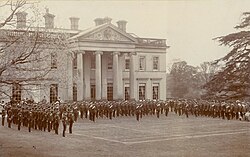
Oswestry is a market town, civil parish and historic railway town in Shropshire, England, close to the Welsh border. It is at the junction of the A5, A483 and A495 roads.

Baron Harlech, of Harlech in the County of Merioneth, is a title in the Peerage of the United Kingdom. It was created in 1876 for the Conservative politician John Ormsby-Gore, with remainder to his younger brother William. He had previously represented Carnarvon and North Shropshire in the House of Commons. Ormsby-Gore was the eldest son of William Ormsby-Gore, Member of Parliament for County Leitrim, Carnarvon and North Shropshire, and the great-great-great-grandson of William Gore, third and youngest son of Sir Arthur Gore, 1st Baronet, of Newtown, second son of Sir Paul Gore, 1st Baronet, of Magharabag, whose eldest son Paul was the grandfather of Arthur Gore, 1st Earl of Arran.

William David Ormsby-Gore, 5th Baron Harlech, known as David Ormsby-Gore until June 1961 and as Sir David Ormsby-Gore from then until February 1964, was a British diplomat and Conservative politician.
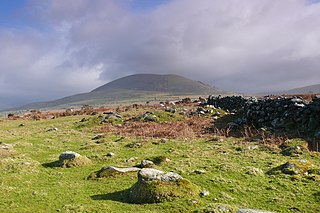
Ardudwy is an area of Gwynedd in north-west Wales, lying between Tremadog Bay and the Rhinogydd. Administratively, under the old Kingdom of Gwynedd, it was first a division of the sub kingdom (cantref) of Dunoding and later a commote in its own right. The fertile swathe of land stretching from Barmouth to Harlech was historically used as pasture. The name exists in the modern community and village of Dyffryn Ardudwy.
William Richard Ormsby-Gore, 2nd Baron Harlech, was an Anglo-Irish peer and Member of Parliament.
Francis David Ormsby-Gore, 6th Baron Harlech, was a peer in the United Kingdom. In 1985 he inherited the property in Wales and the Harlech title from his father.

The National Library of Wales, in Aberystwyth, is the national legal deposit library of Wales and is one of the Welsh Government sponsored bodies. It is the biggest library in Wales, holding over 6.5 million books and periodicals, and the largest collections of archives, portraits, maps, and photographic images in Wales. The Library is also home to the national collection of Welsh manuscripts, the National Screen and Sound Archive of Wales, and the most comprehensive collection of paintings and topographical prints in Wales. As the primary research library and archive in Wales and one of the largest research libraries in the United Kingdom, the National Library is a member of Research Libraries UK (RLUK) and the Consortium of European Research Libraries (CERL).
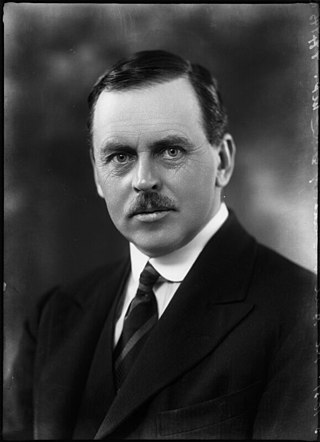
William George Arthur Ormsby-Gore, 4th Baron Harlech,, was a British Conservative politician and banker.

George Ralph Charles Ormsby-Gore, 3rd Baron Harlech,, was a British soldier and Conservative Member of Parliament.
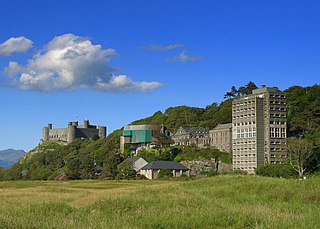
Coleg Harlech was a residential adult education college for mature students in Harlech, Gwynedd, later on part of Adult Learning Wales - Addysg Oedolion Cymru.
Alice Magdalen Sarah Ormsby-Gore was a British aristocrat who was part of the fashion and arts counter-culture in London during the 1960s. For about five years she was the romantic partner of guitarist Eric Clapton. The couple were briefly subjected to media speculation about a possible marriage. She died of a heroin overdose in 1995.

Anwyl of Tywyn are a Welsh family who claim a patrilinear descent from Owain Gwynedd, King of Gwynedd from 1137 to 1170 and a scion of the royal House of Aberffraw. The family motto is: Eryr eryrod Eryri, which translates as "The Eagle of the Eagles of Snowdonia. The family lives in Gwynedd and speak Welsh.
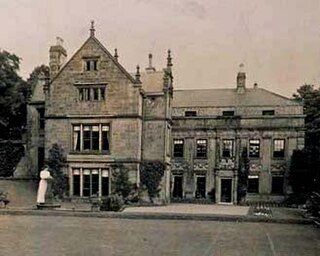
Brymbo Hall, one of Britain's lost houses, was a manor house located near Brymbo outside the town of Wrexham, North Wales. The house, reputed to have been partly built to the designs of Inigo Jones, was noted as the residence of 18th-century industrialist and ironmaster John "Iron-Mad" Wilkinson.

Sir John Owen of Clenennau, was a Welsh landowner from Anglesey, who served with the Royalist army in the Wars of the Three Kingdoms, during which he held various commands in North Wales.

Benjamin Gummow was an architect who worked from Ruabon near Wrexham in Wales. He worked almost exclusively for Sir Watkin Williams Wynn of Wynnstay, Ruabon and the Grosvenor family of Eaton Hall near Chester. He was born in St Endellion in Cornwall in 1766 and died at Ruabon in March 1844.

Nannau is a Georgian mansion and estate near the village of Llanfachreth, Gwynedd, North Wales, UK. The mansion was initially inhabited by the Welsh Nanney (Nannau) family, who were direct descendants of the Kings of Powys. For over 900 years, the Nannau estate was in possession of the same family.
The Honourable Fanny Mary Katherine Bulkeley-Owen was a British historian and author. She was a member of the Anglo-Irish Gore family.
Rowland Vaughan was a Welsh poet, translator and jurist.

Jasset David Cody Ormsby-Gore, 7th Baron Harlech, is a British hereditary peer and Conservative member of the House of Lords. He has been serving as a Lord in Waiting since September 2022.
Giwn Lloyd, 18th Baron of Hendwr (1699–1774) and squire of Tyfos, in the county of Merioneth and of Gwersyllt Park and Plas Newydd, in the county of Denbigh, was a Welsh gentleman who lived in the 18th century and was notorious for his dissolute life. He is best remembered for the lengthy court battle which ensued after his death, lasting over twenty years, exhausting the finances of many of his kinsmen, and shocking much of Welsh society.
